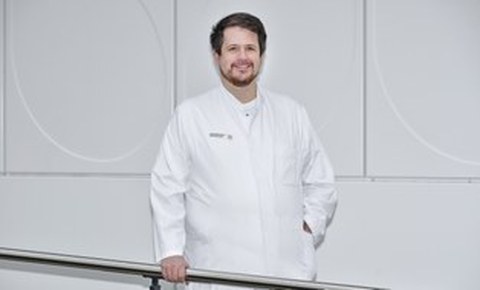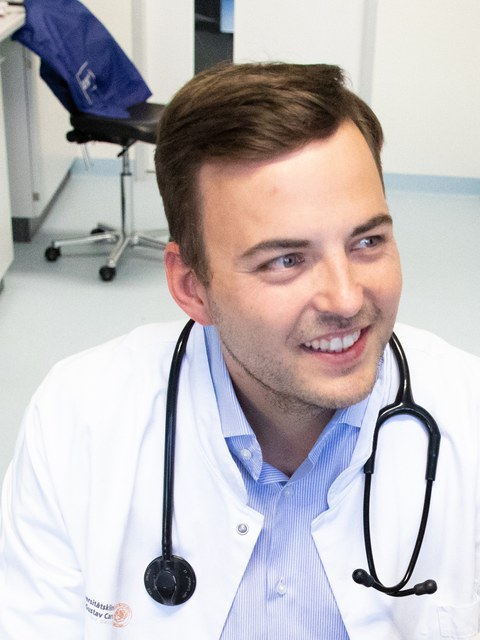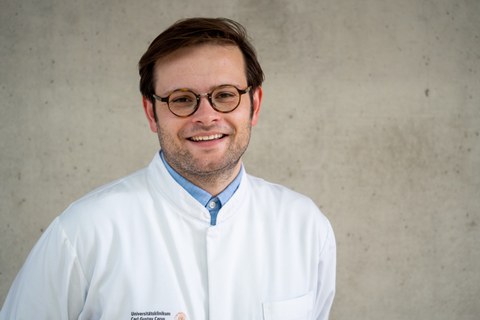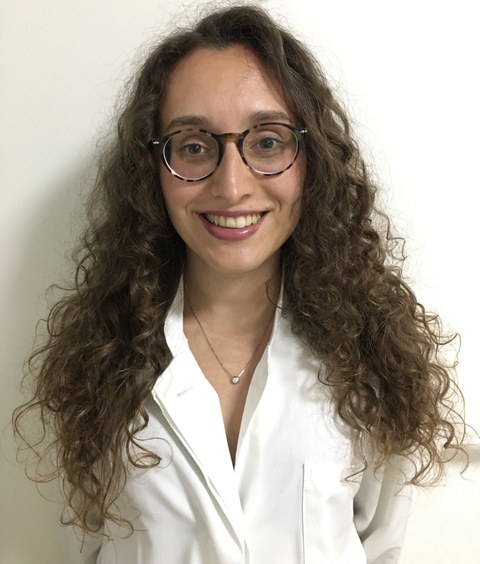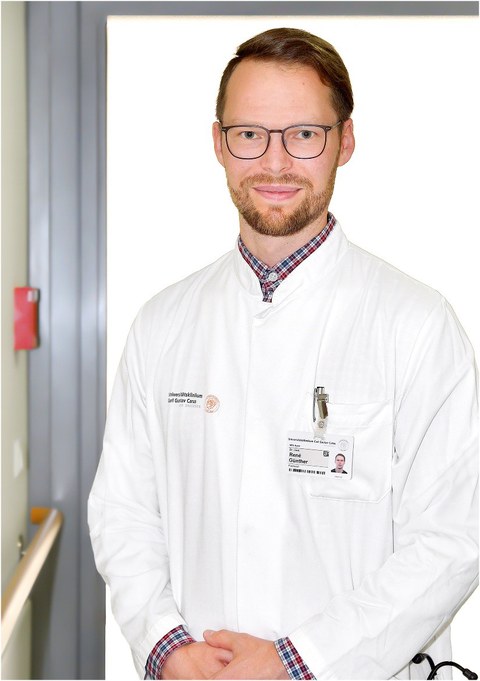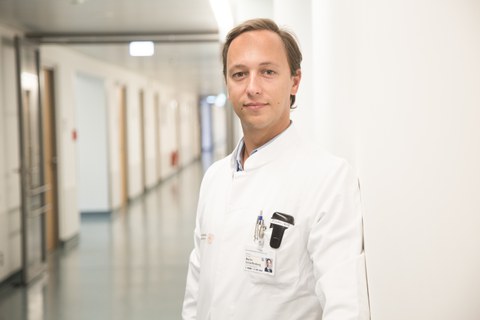Funded scientists 2017-2022/2023
Funded projects 2022/2023
Start
Dr. rer. nat. Marius Bill
Project title: The Biological and Clinical Impact of Circular RNAs in Acute Myeloid Leukemia
Structural unit: Department of internal Medicine I
Project description
Acute myeloid leukemia (AML) is a malignant disease that arises within the hematopoietic system of patients. AML usually originates from the bone marrow, where all blood cells (i.e., red blood cells, leukocytes, thrombocytes) are produced. AML is characterized by an overproduction of impaired and immature white blood cells, which lost their functional ability to fight infections. Healthy blood cells are regenerated at a normal rate and undergo a complex maturation process. AML interferes with this process: the leukocytes are unable to mature into functional cells and instead multiply clonally and uncontrollably. AML progresses rapidly, and without the appropriate treatment, is lethal within a few weeks.
Circular RNAs (circRNAs) is a class of RNAs, which display a perturbed arrangement of exons. This process is called “back-splicing”. We hypothesize that a subset of deregulated circRNAs are functionally and clinically important in AML and may represent viable therapeutic targets as well as novel measurable residual disease (MRD) markers in AML.
Homepage of the project: https://tu-dresden.de/med/mf/msnz/kollegiaten/alexander-wurm-marius-bill
Dr. med. Lars Heubner
Project title: SMART Catheters with wireless data transmission for real-time blood analysis
Structural unit: EKFZ / Department of Anesthesiology and Intensive Care Medicine
Project description
In critical care medicine, real time measurement of key laboratory parameters (e.g. lactate, electrolytes, glucose, oxygenation, acid-base status) that are currently only available as a separate blood test, would improve patient care and individualized treatment. Indwelling catheters are routinely placed in critical ill patients to allow hemodynamic monitoring and/or administration of potent drugs. Currently we are developing a new smart sensor, placed on clinically used indwelling catheters to provide real-time in situ monitoring of essential laboratory parameters, read out by a wired reader device.
In the proposed project, we aim at developing a wireless signal transmission system for our SMART Catheters, in particular to integrate the present sensor platform to the new developed wireless card reader device and verify its functionality in animal experiments. This approach will improve patient centered, individualized therapy guidance, quality of care patient and safety in critically ill patients.
Homepage of the project: https://digitalhealth.tu-dresden.de/enhanced-catheters/
Dr. med. Markus Latk
Project title: Regulation of the sensitivity of ferroptosis by kinases
Structural unit: Department of internal Medicine III
Project description
Incidence and mortality of acute kidney injury (AKI) is highly underestimated in a clinical context. Persistent AKI leads to acute tubular necrosis (ATN) and therefore a severe impaired renal function. Tubular necrosis is a genetically determined process and regulated at a molecular level (regulated necrosis). Necroptosis and ferroptosis have been identified as key pathways in AKI/ATN but an interaction between those has not been described yet.
In this project, we will investigate a potential regulation of ferroptosis by kinases of the necroptosis pathway in different in vivo and in vitro models of AKI.
Link to the working group: https://www.nephrologie-dresden.org/?Grundlagenforschung/AG-Linkermann
Dr. med. Undine Proschmann
Project title: Die Signalpeptidpeptidase like 2a Protease als therapeutisches Target bei der experimentellen autoimmunen Encephalomyelitis
Structural unit: Department of Neurology
Project description
Die Multiple Sklerose (MS) ist eine häufige, chronisch autoimmun-entzündliche Erkrankung des zentralen Nervensystems. Der Entwicklung weiterer Therapiestrategien kommt vor dem Hintergrund der heterogenen immunpathogenetischen Mechanismen der Erkrankung eine tragende Rolle zu. Im etablierten Tiermodell der MS, der experimentellen autoimmunen Encephalomyelitis (EAE), soll erstmals analysiert werden, ob die Signalpeptidpeptidase like 2a Protease (SPPL2a) als Intramembranprotease, ein mögliches Target bei der Behandlung der EAE darstellt. Zusätzlich soll sowohl das prophylaktische als auch therapeutische Potential von einem oralen Hemmstoff (Substrat SPL707) der SPPL2a bei der EAE untersucht werden. Ergänzende Analysen mit humanen PBMC sollen eine in-vitro Evaluation der Effekte von SPL707 im Sinne eines translationalen Ansatzes ermöglichen.
Dr. med. Leo Ruhnke
Project title: Evaluation des TET2 Mutations- und Expressionsstatus als prädiktiver Biomarker für das Ansprechen auf hypomethylierende Substanzen bei PatientInnen mit akuter myeloischer Leukämie
Structural unit: Department of internal Medicine I
Project description
Ten eleven translocation 2 (TET2) Alterationen gehören zu den häufigsten genetischen Veränderungen bei PatientInnen mit akuter myeloischer Leukämie (AML). Unsere Arbeitsgruppe konnte bereits zeigen, dass der TET2 Mutationsstatus mit dem Ansprechen auf hypomethylierende Substanzen (HMS) wie beispielsweise 5-Azacytidin korreliert. Entsprechend wollen wir nun die TET2 Expression auf AML Zellen als prädiktiven Biomarker prüfen. Hierfür soll in einem ersten Schritt die TET2 Expression in myeloischen Zelllinien u.a. mRNA-basiert mittels PCR sowie durchflusszytometrisch ermittelt und das Ansprechen auf HMS in-vitro untersucht werden. Anschließend soll die TET2 Expression in primären AML Zellen untersucht und retrospektiv mit Daten zum Therapieansprechen und Überleben der entsprechenden PatientInnen korreliert werden. Ziel ist es durch Etablierung eines neuartigen prädiktiven Biomarkers die Therapiestratifikation und somit die Prognose von PatientInnen mit AML zu optimieren. Längerfristiges Ziel dieser Arbeiten ist die Initiierung einer klinischen Therapiestudie für PatientInnen mit myeloischen Neoplasien mit HMS in Abhängigkeit vom TET2-Expressionsstatus.
Dr. Giulia Trimaglio
Project title: Mesenchymal stromal cells-derived mitochondrial transfer to hematopoietic and immune cells and its functional consequences
Structural unit: Institute of Clinical Chemistry and Laboratory Medicine
Project description
Mesenchymal stromal cells (MSCs) have multiple functions including as niche-supporting cells for hematopoietic stem cells in the bone marrow or potent immunomodulatory functions. One of the recently demonstrated mechanisms mediating MSCs-derived immunosuppressive and anti-inflammatory activities is mitochondrial transfer (MitoT) to recipient immune cells. The proposed research aims at evaluating MitoT to different hematopoietic progenitors and mature immune cells and its functional consequences paving the way for innovative studies exploring the functional meaning of MitoT that still remains largely unaddressed.
Grant
Frau Dr. rer. nat. Nicole Bechmann
Project title: Adaptierte oxidative Stressantwort: Einfluss auf Tumorprogression und Metastasierung in Phäochromocytomen und Paragangliomen
Structural unit: Institute of Clinical Chemistry and Laboratory Medicine
Project description
Phäochromocytome und Paragangliome (PPGL) sind genetisch heterogene Tumore, mit einer starken Genotyp-Phänotyp Korrelation. Mutationen in einer der Succinat-Dehydrogenase Untereinheiten (SDHx) oder dem Hypoxie-induzierten Faktor (HIF) 2α sind beispielsweise mit einem pseudohypoxisch Phenotyp assoziiert, dieser neigt zu einer erhöhten Metastasierungsrate. Eine übermäßige Produktion von reaktiven Sauerstoffspezies (ROS) und dem daraus resultierenden oxidativen Stress trägt weiterhin zum pseudohypoxischen Phänotyp dieser Tumore bei. Trotz der Kenntnis der zugrundeliegenden Mutationen und den damit verbundenen molekularen Charakteristika, fehlen derzeit effektive Therapieoptionen für metastasierende PPGL. Das Projekt adressiert daher die Hypothese, dass eine Adaption an die konstitutiv erhöhten oxidativen Stresslevel einerseits zu einer gesteigerten Tumorprogression und -metastasierung führt und darüber hinaus auch mit einer erhöhten Therapieresistenz dieser pseudohypoxischen PPGL einhergeht. Dazu soll zunächst untersucht werden, ob spezifische DNA-Reparatur- sowie Detoxifikationsmechanismen unter pseudohypoxischen Bedingungen dysreguliert sind. Langfristiges Ziel des Projektes ist es zu klären, ob eine gezielte Modulation der identifizieren Mechanismen für die individuelle Behandlung von metastasierenden PPGL verwendet werden kann. In geeigneten Phäochromocytom-Zellmodelle, mit unterschiedlicher Hif2α- bzw. Sdhb-Expression, soll zunächst untersucht werden, wie sich der oxidative Stressstatus in Abhängigkeit von Hif2α bzw. Sdhb ändert. Diese Ergebnisse sollen anschließend mit den pro-metastatischen Eigenschaften der Zellen korreliert werden. Eine Behandlung der Zellen mit ausgewählten Chemotherapeutika in An- sowie Abwesenheit von Verbindungen, die das oxidative Stresslevel der Zellen modulieren, soll Aufschluss darüber geben, ob dieser Ansatz möglicherweise auch für eine adjuvante, chemosensibilisierende Therapie in PPGL geeignet ist. Die Bestimmung von oxidativen Stressmarkern in flüssigen Biopsien von PPGL-Patienten soll darüber hinaus verwendet werden, um zu überprüfen, ob diese Marker dafür geeignet sind, ein erhöhtes Metastasierungsrisiko für spezifische Patientengruppen vorherzusagen. Die Bestimmung der oxidativen Stresslevel und der antioxidativen Kapazität in Tumorgewebe und Metastasen, in Kombination mit vorhandenen Transkriptom-Daten, soll darüber hinaus für die Identifizierung potentieller therapeutischer Ziele verwendet werden. Durch die klinische Relevanz und den verfolgten translationalen Ansatz, wird das Projekt einen entscheidenden Beitrag für das Verständnis von oxidativen Stress sowie für die Diagnose und Therapie von PPGL leisten.
Dr. med. René Günther
Project title: Reading the palm – hand and finger flexion strength patterns as a biomarker in patients with motoneuron diseases (MND)
Structural unit: Department of Neurology
Project description
Motoneuron diseases (MND) leading to degeneration of motoneurons (MN) with disease-specific muscle weakness patterns and variable individual disease courses. Valid functional biomarkers are urgently needed to prove treatment concepts with even small effects and to improve the knowledge of disease specific degeneration patterns. Maximum isometric voluntary grip and finger flexion strength (GFFS) enables quantitative assessment of muscle weakness and will provide information about disease specific strength loss distribution patterns in different MND. In this monocentric, cross-sectional pilot study we will analyze GFFS of the individual fingers in distal and intermediate phalanges in MND with a new, non-commercially, specifically designed device. 28 strength parameters of both hands will be compared between the different MND types (amyotrophic lateral sclerosis (ALS), hereditary spastic paraplegia (HSP), primary lateral sclerosis (PLS), spinal muscular atrophy (SMA) und spinal-bulbar muscular atrophy (SBMA)) and to healthy controls. Additionally, the strength parameters will be correlated to MND-specific clinical, fluid and functional markers. The aim of this study is to identify disease specific muscle wasting patterns in the hand (‘reading the palm’) of different MND and to establish a functional marker of disease progression/severity using a non-commercially, specifically designed hand- and finger grip strength device.
Project partner: Frau Constanze Weber
Website lab group: www.als-dd.de
Website donation: https://stiftung-hochschulmedizin.de/als-forschung/
Dr. rer. medic. Robert Huhle
Project title: Effects of thoracoabdominal negative pressure on regional ventilation and pulmonary distension during assisted positive pressure ventilation in porcine animal acute respiratory distress syndrome
Structural unit: Department of Anesthesiology and Intensive Care Medicine, Pulmonary Engineering Group
Project description
Acute respiratory distress syndrome (ARDS) often requires mechanical ventilation of patients. In the early phase of severe ARDS, this is mainly performed as controlled ventilation, while the patient's own respiratory drive is suppressed with medication. Sustained patient spontaneous breathing activity may increase transpulmonary pressure, further exacerbating existing lung injury. However, experimental studies also demonstrated beneficial effects of spontaneous breathing activity, such as improved distribution of pulmonary ventilation and perfusion and reduced risk of ventilator-induced diaphragmatic dysfunction. Moreover, with sufficient alveolar stabilization, spontaneous breathing activity did not increase pulmonary inflammation. This alveolar stabilization can classically be achieved by adequate positive end-expiratory pressure (PEEP), but this can have both haemodynamic and respiratory adverse effects. However, a targeted influence on lung mechanics in the sense of alveolar recruitment and stabilization also seems possible in another way, namely with the aid of a constant externally applied negative pressure (Continuous external negative pressure, CENP). For this purpose, a negative pressure is applied via a hard plastic shell placed airtight on the abdomen. The principle is similar to that of the iron lung, but differs significantly from the historical model in terms of the scope and complexity of the application. It is thus not necessary to transfer the patient to a closed chamber and the patient remains accessible. Gas exchange, ventilation distribution and lung mechanics could be improved in the muscle-relaxed, classically machine ventilated pig with lung damage induced by surfactant washout.
The aim of the proposed project is to investigate the influence of CENP during spontaneous breathing on lung function, lung mechanics, regional distribution of aeration, ventilation, and haemodynamics in an animal crossover study. The results will be used to improve the understanding of the mechanisms of ventilator-induced lung injury (VILI) and thus improve ventilation therapy. A necessary proof of the protective effect of CENP with regard to the development of VILI will then take place within the framework of an elaborate longitudinal investigation of pulmonary inflammation by means of PET/CT or molecular biological post-mortem parameters within the scope of a DFG project.
Link to the work group: http://www.peg-dresden.de
Frau Dr. med. Désirée Kunadt
Project title: Charakterisierung extramedullärer AML Manifestationen per Transkriptom- und Proteomanalysen zur Detektion primärer und sekundärer Resistenzmechanismen als therapeutische Targets
Structural unit: Department of internal Medicine I
Project description
Ein relevanter Anteil an Patienten, die an einer akuten myeloischen Leukämie (AML) erkrankt sind, weisen zum Diagnosezeitpunkt oder im Therapieverlauf extramedulläre Manifestationen ihrer AML auf (EM-AML). Klinisch sind diese durch aggressive und refraktäre Verläufe, sowie durch hohe Rezidivraten charakterisiert und gehen trotz intensiver Therapieverfahren mit einer insgesamt schlechten Prognose einher. Funktionell wie molekularbiologisch sind diese EM bislang nur unzureichend beschrieben. Das Aufzeigen genomischer Unterschiede und funktioneller Besonderheiten der EM-AML, sowie die Detektion bestehender Resistenzmechanismen und potentieller therapeutischer Targets soll das Verständnis der zugrundeliegenden Erkrankungsbiologie erweitern um neue therapeutische Ansätze zu ermöglichen.
PhD Susan Richter
Project title: Comprehensive functional variant classification using saturation editing in succinate dehydrogenase B
Structural unit: Institute of Clinical Chemistry and Laboratory Medicine
Project description
Patients with hereditary syndromes caused by mutations in succinate dehydrogenase genes have an increased risk for developing a multitude of different tumours, including phaeochromocytomas/paragangliomas, gastrointestinal stromal tumours, and renal cell carcinomas. Regular tumour screening of germline mutation carriers is paramount for early detection and preventing metastatic disease. The funded project is a collaboration with the Institute of Clinical Genetics, with whom we are developing a method that allows for simultaneous functional characterization and classification of many variants of unknown significance. This is important for patients with such gene aberrations und their relatives to ensure adequate clinical management.
Dr. med. Martin Scharffenberg
Project title: Effects and mechanisms of negative end-expiratory pressure during flow-controlled ventilation on lung injury, function, and mechanics in hypovolemic pigs
Structural unit: Department of Anesthesiology and Intensive Care Medicine, Pulmonary Engineering Group
Project description
Trauma patients in hypovolemic shock often require circulatory stabilization while avoiding overly aggressive volume therapy, as well as mechanical ventilation. In this case, ventilation with negative end-expiratory pressure instead of the usual positive end-expiratory pressure (NEEP instead of PEEP) can improve hemodynamics and stabilize the circulation despite restrictive volume therapy. In contrast to current ventilation concepts, in which end-expiratory collapse of alveoli is usually prevented by PEEP, NEEP provokes collapse as well as cyclic opening and closing of alveoli. The extent to which this contributes to so-called ventilator-associated lung injury is controversial. In this randomized-controlled study, the effects and mechanisms of action of NEEP during flow-controlled ventilation on the structural integrity, function and mechanics of the lungs as well as hemodynamics in lung-healthy, volume-depleted pigs will be investigated and compared to ventilation with PEEP.
Link to the work group: www.peg-dresden.de
Dr. rer. nat. Mario Schubert
Project title: Investigating the mechanisms of cardiomyocyte-cardiac fibroblast crosstalk in models of human atrial- and ventricular tissues
Structural unit: Institute for Pharmacology and Toxicology
Project description
Studies published within the last years highlight the critical role of cardiac fibroblasts (FB) for the development of the heart and the functionality of cardiomyocytes (CM) in physiological as well as pathophysiological states. However, the understanding of the molecular pathways in the bidirectional CM-FB crosstalk lacks behind. In this project, we aim to investigate the underlying mechanisms of our previous finding, demonstrating the critical role of atrial- and ventricular FB in the fate determination of early-state human induced pluripotent stem cell-derived cardiomyocytes (hiPSC-CM) towards chamber-specific functionality in human engineered heart muscles. We hypothesize that direct cell-cell interactions between cardiac FB and CM are most important for the distinct influence of atrial and ventricular FB on functionality of hiPSC-CM.
Different co-culture experiments of hiPSC-CM with atrial- and ventricular FB in cardiac organoids and standard 2D-cultures will be performed, which allow the comprehensive characterization of CM functionality, cell-cell interactions and specific signaling pathways based on gene- and protein-expression. Furthermore, we will apply factors to induce myofibroblast differentiation of atrial and ventricular FB, and investigate the role of the cardiac FB-subtypes on the function of terminally differentiated atrial or ventricular CM during induction of fibrosis. Our studies will establish experimental model systems to investigate the relevance of the CM-FB crosstalk for the chamber-specific functionality of CM and in the presence of pathological stimuli.
Dr. Deepika Watts
Projekt title: The impact of hypoxia signaling in the adrenal cortex
Structural unit: Institute of Clinical Chemistry and Laboratory Medicine
Project description
The adrenal gland is a central endocrine organ responsible for the production of hormones (steroids and catecholamines) crucially involved in the regulation of vital physiological and pathological processes in our body. Recently, we revealed an essential role for Hypoxia Inducible Factor (HIF-1α), one of the rate limiting transcription factors during episodes of deprived oxygen, in the regulation of steroidogenesis in the adrenal cortex and beyond. Additionally, we found that HIF-2α is a central mediator for the production and secretion of adrenaline from the adrenal medulla. During the course of these research projects, we generated a unique collection of conditional knock-out mouse lines of different hypoxia pathway proteins (HPPs) in the main compartments of the adrenal gland that is the basis for my MeDDrive project. With these lines and newly developed tools, I recently obtained a set of exciting preliminary data that I want to further explore to understand the role of HPPs in the adrenal gland and beyond. More in particular, I want to expand our knowledge on: 1) the role of cortical HPPs on rosette based adrenal cortex morphogenesis, 2) the chronic hormonal changes on the production and function of regulatory T cells and 3) the systemic use of Roxadustat, an HPP regulator, and its potential impact on the renin-angiotensin II-aldosterone system (RAAS).
Dr. med. Jakob Wittenstein
Project title: Modulation of the Hippo-YAP pathway in the alveolar epithelium by dynamic cell stretch – a proof-of-concept study
Structural unit: Department of Anesthesiology and Intensive Care Medicine
Project description
Mechanische Beatmung ist eine lebensrettende Therapie, die jedoch das Risiko birgt, einen bestehenden Lungenschaden zu verstärken und zur sogenannten beatmungsinduzierten Lungenschädigung zu führen. Die übermäßige Dehnung der Lunge während der mechanischen Beatmung aufgrund hoher Volumina und Atemwegsdrücke führt zur Produktion und Freisetzung von inflammatorischen Zytokinen mittels verschiedener Signalwege. Im geplanten Projekt soll die Rolle des Hippo-YAP (Yorkie-homologes Yes-associated protein) Signalwegs in der Entstehung des Dehnungs-abhängigen Lungenschadens in Alveolar-Epithel-Zellen untersucht werden.

